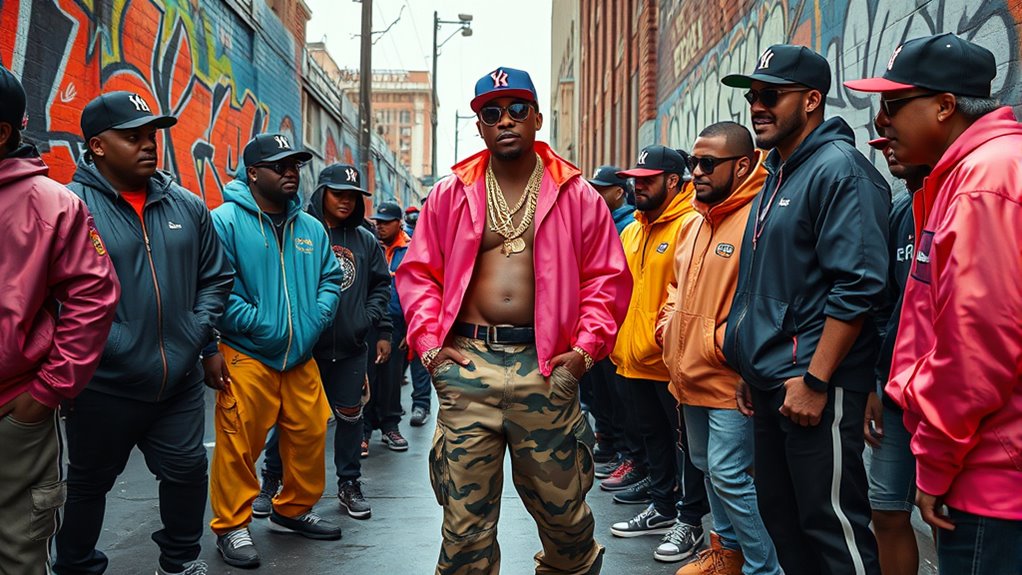In the ’90s, hip-hop changed high fashion by blending streetwear with luxury styles. You’d see oversized tees, baggy jeans, and chunky sneakers become symbols of attitude, identity, and success. Celebrities popularized brands like Nike and Adidas, turning streetwear into high-demand fashion statements. This cultural shift made urban style mainstream and inspired designers worldwide. If you want to explore how this revolution continues to influence today’s fashion, there’s more to discover ahead.
Key Takeaways
- Hip-hop popularized streetwear items like oversized tees, baggy jeans, and chunky sneakers as fashion symbols of attitude and identity.
- Celebrity endorsements from rappers elevated streetwear brands like Nike, Adidas, and Tommy Hilfiger into high fashion status.
- The cultural exchange blurred lines between streetwear and high couture, integrating hip-hop’s raw energy into mainstream fashion.
- Hip-hop’s influence democratized fashion, making urban styles and brands like FUBU and Karl Kani widely accepted and aspirational.
- Artists and designers from hip-hop blurred traditional fashion boundaries, laying the foundation for today’s streetwear-dominated industry.

In the ’90s, hip-hop didn’t just shape music; it revolutionized fashion by blurring the lines between streetwear and high couture. You could see this shift everywhere—on city streets, runways, and in magazine spreads. The streetwear evolution accelerated as hip-hop artists started to wear oversized tees, baggy jeans, and chunky sneakers, transforming these items from mere comfort wear into statements of style and attitude. These looks weren’t just about practicality; they became a cultural language that communicated identity, success, and rebellion. As hip-hop grew in popularity, so did its influence on fashion, turning streetwear into a powerful tool for self-expression. The integration of creative practice into fashion design also helped propel this movement, as designers drew inspiration from the raw energy and authenticity of hip-hop culture.
Celebrity endorsements played a vital role in this transformation. When rappers and hip-hop icons flaunted brands like Nike, Adidas, and Tommy Hilfiger, they turned these labels into symbols of credibility and luxury. You saw artists like Tupac, Notorious B.I.G., and LL Cool J rocking Nike Air Force 1s or Adidas tracksuits, making these items highly desirable beyond their functional purpose. This endorsement effect wasn’t just about wearing brands; it created a cultural currency that elevated streetwear into the domain of high fashion. Designers took notice of this shift, and luxury houses began to incorporate street-inspired elements into their collections, inspired by the authenticity and edge of hip-hop culture.
The influence of celebrity endorsements helped democratize fashion in a way. It wasn’t just about runway models anymore; it was about real people, especially those from urban communities, influencing what was considered stylish and aspirational. You could see this in collaborations like FUBU and Karl Kani, brands that emerged directly from hip-hop communities and gained mainstream attention through celebrity support. These brands embodied the streetwear evolution, showing that style didn’t have to be confined to exclusivity; it could be rooted in everyday life and still command high regard.
This era marked a pivotal moment where streetwear gained legitimacy and respect within high fashion circles. Your favorite hip-hop artists weren’t just music icons—they became tastemakers who shaped trends, influencing designers and consumers alike. The crossover was seamless, breaking down barriers between the two worlds. As a result, the ’90s laid the foundation for today’s streetwear-dominated fashion landscape, proving that authenticity, celebrity influence, and cultural relevance could redefine what high fashion truly means.
Frequently Asked Questions
How Did Hip-Hop Artists Influence Luxury Fashion Branding?
You see, hip-hop artists revolutionized luxury fashion branding by forging powerful branding partnerships and fostering cultural exchange. Their influence pushes brands to embrace streetwear aesthetics, blending exclusivity with urban culture. By collaborating with artists, brands tap into new markets and authenticity. This cultural exchange not only elevates the brands’ image but also makes high fashion more relatable and accessible, shaping trends that resonate across diverse audiences.
Which Specific High Fashion Designers Collaborated With Hip-Hop Artists?
They say, “great minds think alike,” and that’s true in fashion. You’ll find many designer collaborations and fashion sponsorships with hip-hop artists, like Dapper Dan with Gucci, FUBU with Karl Kani, and Versace with Tupac. These collaborations shaped the ’90s style, blending streetwear with luxury. You see, when artists and designers join forces, they create iconic looks that influence culture and high fashion alike.
What Role Did Music Videos Play in Fashion Trends During the ’90s?
Music videos in the ’90s shaped fashion trends by showcasing bold music video aesthetics that viewers emulated. As you watched your favorite artists, their celebrity style influence became clear, inspiring you to adopt similar looks. These videos served as visual showcases of cutting-edge fashion, encouraging fans like you to embrace daring outfits, flashy accessories, and streetwear styles, making music videos a powerful tool in setting and spreading fashion trends during that era.
How Did Streetwear Evolve Alongside High Fashion in the ’90s?
Imagine a revolution happening right before your eyes—streetwear and high fashion intertwining like old friends. You see sneaker culture booming, driven by hip-hop’s bold style, while graffiti art brings urban grit into runway shows. Together, they blur boundaries, making streetwear not just casual but a statement of identity and rebellion. This evolution transforms fashion from exclusive to accessible, creating a vibrant, cultural mosaic that echoes the energy of ’90s urban streets.
Were There Any Legal or Ethical Controversies Related to This Fashion Influence?
You might wonder if legal or ethical issues arose from this fashion influence. Yes, you’ll find copyright disputes over designs mimicking luxury brands, leading to legal battles. Cultural appropriation also sparked controversy, as some argued that streetwear borrowed from marginalized cultures without proper respect or acknowledgment. These issues highlight ongoing debates about originality and respect in fashion, especially when subcultures intersect with high-end labels.
Conclusion
As you step back and look at the ’90s, hip-hop is like a vibrant paintbrush, splattering bold colors across the blank canvas of high fashion. Its influence reshapes the runway, turning it into a street-style gallery where swagger and style collide. You can see the fusion as a powerful wave crashing onto the shores of high society, forever transforming the landscape. This era proves that fashion isn’t just worn—it’s spoken, shouted, and lived through every beat and bold statement.










